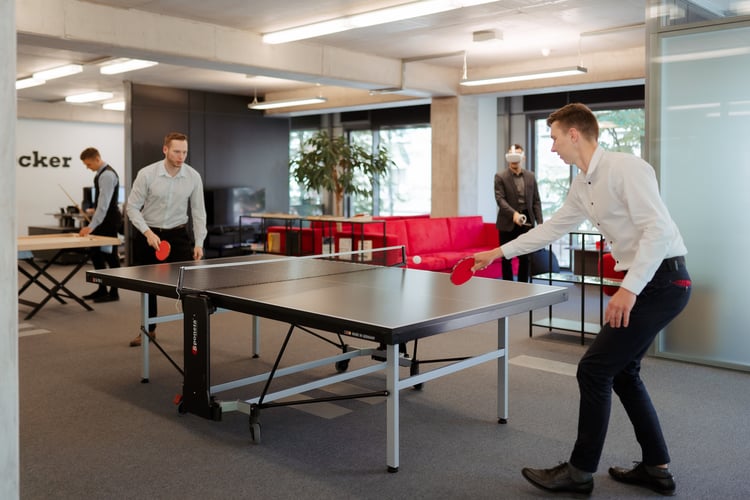What Culture Are You Really Promoting?

By Robert Hosking, Co-Founder of Rise of Happiness
In the age of open-plan offices, bean bags, ping-pong tables and foosball tables, it's easy for businesses to tout their commitment to a positive workplace culture. They proudly display their shiny perks, hoping to attract top talent and create a vibrant atmosphere. However, beneath the surface, there often lies a stark contrast between what businesses claim to promote and the actual culture they nurture. True workplace culture isn't found in the amenities, but rather, it's defined by how employees are treated. After all, it's the people who make the business, and if they aren't treated right, the culture can never truly thrive.
THE ILLUSION OF WORKPLACE CULTURE
Walk into any modern office, and you'll likely encounter an array of amenities designed to convey a relaxed and fun work environment. Ping-pong tables and themed meeting rooms are now common fixtures in many workplaces. These perks may give the impression of a vibrant culture, but they are only surface-level adornments.
The problem arises when businesses prioritise these superficial elements over the wellbeing and treatment of their employees. The ping pong table may be a fun distraction, but it doesn't address the core issues that impact the employees' daily lives. In reality, such amenities can often serve as distractions, masking deeper problems like overwork, burnout, or a lack of respect and appreciation.
THE HEART OF WORKPLACE CULTURE
Good workplace culture is rooted in how employees are treated on a daily basis. It's about fostering an environment where individuals feel valued, respected, and supported in their professional and personal growth. No longer can employers deny the importance of happy staff as research has shown that happy staff are 13% more productive. So, what can businesses do to cultivate a positive workplace culture internally rather than just externally?
- Respect and Inclusivity:
A thriving culture begins with treating all employees with respect, dignity, and fairness. This means creating an inclusive environment where diversity is celebrated, and discrimination is never tolerated.
- Clear Communication:
Open and transparent communication is vital. Employees should feel free to express their ideas, concerns, and feedback without fear of retribution. Effective communication builds trust and engagement.
- Life Balance:
There is no such thing as work-life balance. Although businesses can’t fully make you happy, they can make you unhappy. So, when we spend two-thirds of our life at work, why is there such a thing as work-life balance? When work can impact our moods and sit in our thoughts, how can there be a thing such as work-life balance? So, an organisation promoting a healthy life balance is essential for employee wellbeing. Overworking employees can lead to burnout and a decline in productivity. Encouraging employees to take breaks and prioritise self-care can lead to happier, more motivated staff.
- Recognition and Appreciation:
Acknowledging and appreciating employees for their contributions is a cornerstone of a positive culture. Whether through verbal recognition, promotions, or rewards, acknowledging hard work fosters a sense of belonging and motivation. This also leads to the idea of promoting the right people in your organisation. No longer can businesses promote people because their face fits. No longer can they refuse to acknowledge the hard work of certain individuals. Appreciation and recognition need to be shown clearly now.
- Personal and Professional Growth:
Supporting employees in their personal and professional development is key to a positive culture. Providing opportunities for training, mentorship, and advancement shows a commitment to their growth. As Richard Branson says, “Train people well enough so they can leave, treat them well enough, so they don't want to.”
- Employee Wellbeing:
Creating a workplace that prioritises the physical and mental wellbeing of employees is paramount. This can include offering mental health resources, flexible work arrangements, and wellness programs. All these are important aspects of a good working culture, but organisations also need to focus on how they treat and speak to their staff. These things will have far better results than the mental health resources an organisation can offer.
THE IMPORTANCE OF EMPLOYEE WELLBEING
Employee wellbeing should be at the forefront of any organisation's culture strategy. When employees are healthy, happy, and motivated, they are more likely to be productive and innovative. Conversely, a culture that neglects wellbeing can lead to high turnover, decreased morale, and ultimately, a negative impact on the bottom line.
Moreover, fostering a culture of wellbeing can help attract top talent. In today's competitive job market, potential employees are increasingly looking beyond ping-pong tables and free snacks. They want to know that they will be valued, supported, and able to maintain a healthy life balance where they will be treated with dignity and respect. No longer can organisations have their staff merely surviving at work. Staff need to be thriving and that can only be done when they are happy.
THE EXAMPLES
The examples are there to be observed but here are just a few.
What organisations say vs. What is really said:
- “Work-life balance is important.” – “Is that you leaving already?”
- “Trust and confidentiality are paramount.” – “So, what gossip did I miss?”
- “Treating staff with respect is a must.” – “Shut up and get on with it.”
Although these examples do not tell the story of every organisation out there, they do highlight a concerning trait that exists. What some businesses say and do are completely different, and this is what needs to change.
In the quest to promote a positive workplace culture, businesses must shift their focus from superficial perks to the wellbeing and treatment of their employees. Ping-pong tables and bean bags may be fun, but they are no substitute for respect, inclusivity, clear communication, and support for personal and professional growth. People are the heart of any organisation, and a culture that prioritises their wellbeing will reap the benefits of happier, more engaged, and more productive employees. Happy staff is paramount to organisational success. As KFC puts it, happy people make better chicken. That’s a scientific fact. Ultimately, the question remains: What culture are you sreally promoting in your workplace?




